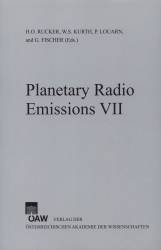
Planetary Radio Emissions VII, pp. 359-366, 2011/12/28
Proceedings of the 7th International Workshop on Planetary, Solar and Heliospheric Radio Emissions held at Graz, Austria, September 15–17, 2010

It is currently accepted that the dependences of frequency drift rate and instant duration of type III bursts on frequency follow a monotonic function. The observations carried out during summer months of 2002-2006 by the world largest decameter wavelength radio telescope UTR-2 in frequency band 10-30 MHz show that sometimes these dependences may have a jump at some frequency, when the steepness of the dependence changes step-wise. In this paper the results of observations of such unusual type III bursts are given. Since the dynamic spectrum of such bursts resembles a dog’s leg we call them “dog-leg” type III bursts. More than a hundred of these “dog-leg” bursts were observed during 5 years. The parameters of the 41 bursts observed in 2002 were defined and statistically analyzed. The fact that “dog-leg” type III bursts are observed on the background of standard type III bursts allows to exclude any instrumental component of the observed phenomena.